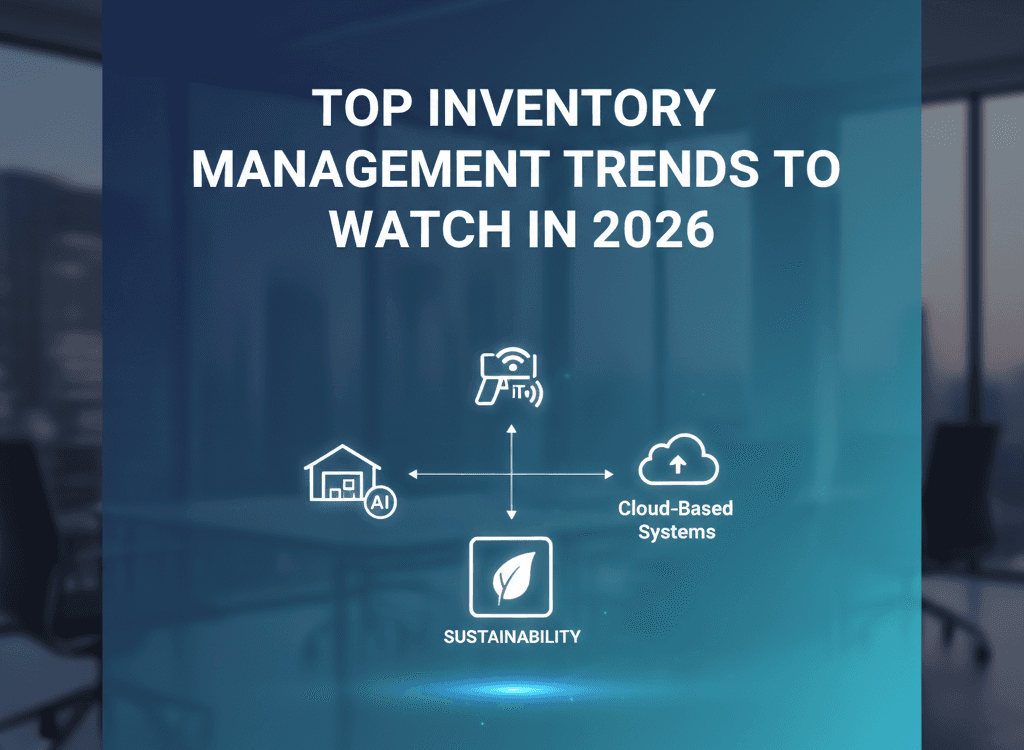Top Inventory Management Trends to watch in 2026
Discover the top inventory management trends for 2026, from AI forecasting to IoT visibility, automation, and sustainable practices.

Top Inventory Management Trends to Watch in 2026
The supply chain world is evolving faster than ever—and inventory management is at the center of that transformation. Once a largely reactive process, inventory management is now proactive, data-driven, and powered by advanced technology.
As we head into 2026, businesses are rethinking how they forecast demand, track stock, and optimize operations. From artificial intelligence to automation, these trends are setting the pace for the future of supply chain success.
Below, we break down the most important inventory management trends for 2026 and how your business can leverage them to stay ahead.
1. AI & Machine Learning: Smarter Demand Forecasting
Artificial intelligence (AI) and machine learning are no longer optional—they’re essential tools for modern inventory strategies. Businesses are moving beyond historical sales reports and tapping into predictive analytics that factor in:
- Customer behavior
- Market shifts and seasonality
- Weather forecasts
- Social media sentiment
These insights help reduce stockouts, avoid costly overstocks, and optimize reorder points. That said, AI works best when paired with human insights—collaborative data from employees, customers, and vendors still plays a critical role in fine-tuning demand forecasts.
The result? Faster, smarter decisions and a significant competitive advantage in fast-moving markets.
2. Sustainable Inventory: Going Green and Circular
Sustainability has moved from a “nice-to-have” to a business imperative. Consumers and regulators alike are holding companies accountable for their environmental impact.
In 2026, expect to see more businesses embrace:
- Eco-friendly packaging and reusable containers
- Reverse logistics for returns and recycling
- Carbon and energy tracking tools across the supply chain
By optimizing transportation routes, sourcing locally, and measuring environmental impact, companies not only reduce waste but also strengthen customer loyalty. Green practices aren’t just good for the planet—they’re good for business.
3. Real-Time Visibility with IoT and Cloud
Inventory visibility is being transformed by Internet of Things (IoT) devices and cloud-based platforms.
Smart sensors embedded in warehouses, vehicles, and even store shelves provide real-time data on stock levels, location, and condition. These connect to centralized cloud dashboards that enable:
- Automated restocking alerts
- Geo-tracking for in-transit goods
- Condition monitoring for perishables and sensitive products
This real-time control reduces shrinkage, eliminates manual errors, and allows supply chains to respond quickly to disruptions. Industries like food, pharmaceuticals, and automotive are already seeing massive benefits.
4. Warehouse Automation & Robotics
Automation continues to reshape warehouse operations, making them faster, safer, and more cost-efficient.
Technologies gaining ground include:
- Autonomous mobile robots (AMRs)
- Robotic picking systems
- Conveyor and sorting automation
When integrated with inventory management systems, these tools deliver real-time updates and reduce reliance on manual labor. Warehouses benefit from higher throughput, lower operating costs, and scalable solutions during peak demand.
5. Personalized Inventory Strategies with Data Analytics
One-size-fits-all approaches no longer work. Businesses are increasingly using advanced analytics—paired with collaborative data from vendors, sales teams, and customers—to craft tailored inventory strategies.
This enables:
- Location-specific stocking plans
- Dynamic safety stock levels
- Promotions aligned with inventory turnover rates
Personalized strategies make businesses more agile and better equipped to meet customer needs across regions and channels.
6. Cloud-Native Inventory Systems
Legacy inventory software is being phased out in favor of cloud-native platforms that deliver flexibility, scalability, and real-time collaboration.
Key benefits include:
- Remote access from any device
- Seamless integration with ERP, CRM, and e-commerce tools
- Real-time synchronization across distributed teams
Cloud-native systems keep data flowing across departments and supply chain partners, ensuring everyone is aligned.
7. Inventory-as-a-Service (IaaS)
Outsourcing is moving into inventory management. With Inventory-as-a-Service (IaaS), businesses hand off routine tasks like replenishment to specialized providers.
IaaS solutions offer:
- Scalable warehousing options
- Advanced tracking technologies
- Expert forecasting and fulfillment support
By letting specialists handle repetitive work, companies can “manage by exception”—focusing only on issues that truly require their expertise.
8. Building Resilience Through Scenario Planning
The pandemic underscored just how fragile supply chains can be. In 2026, resilience is a priority.
Businesses are using AI-powered scenario modeling—supplemented by human input—to prepare for disruptions like supplier shortages, transportation delays, or geopolitical events. This allows companies to:
- Identify weak links in the supply chain
- Diversify supplier networks
- Build contingency stock plans
The result is a more resilient, responsive inventory strategy capable of weathering unexpected challenges.
Staying Ahead in 2026
The trends shaping inventory management in 2026 go far beyond buzzwords. They represent lasting shifts in how businesses forecast, track, and optimize their stock.
Companies that embrace AI, IoT, sustainability, and cloud-based solutions—while also leveraging human expertise—will be best positioned to thrive.
Whether you’re a small retailer or a multinational enterprise, adapting to these trends isn’t just about staying competitive—it’s about building the future of inventory management.



